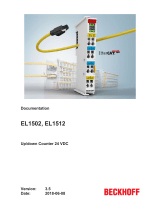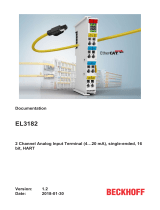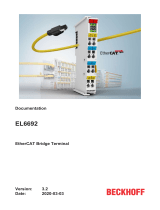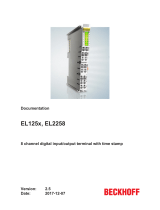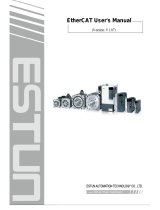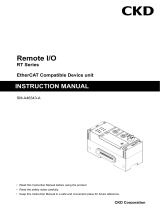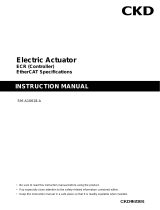Page is loading ...

Documentation
EL72x1-0010
Servo Motor Terminals with OCT (One Cable Technology)
2.0
2015-11-30
Version:
Date:


Table of contents
Table of contents
1 Product overview Servomotor terminal .................................................................................................3
2 Foreword ....................................................................................................................................................6
2.1 Notes on the documentation............................................................................................................. 6
2.2 Safety instructions ............................................................................................................................ 7
2.3 Documentation issue status.............................................................................................................. 8
2.4 Version identification of EtherCAT devices....................................................................................... 8
3 Product overview.....................................................................................................................................12
3.1 Introduction ..................................................................................................................................... 12
3.2 Technical data ................................................................................................................................ 14
3.3 Technology ..................................................................................................................................... 14
3.4 Start ................................................................................................................................................ 17
4 Basics communication ...........................................................................................................................18
4.1 EtherCAT basics............................................................................................................................. 18
4.2 EtherCAT cabling – wire-bound...................................................................................................... 18
4.3 General notes for setting the watchdog .......................................................................................... 19
4.4 EtherCAT State Machine ................................................................................................................ 21
4.5 CoE Interface.................................................................................................................................. 23
4.6 Distributed Clock............................................................................................................................. 28
5 Installation................................................................................................................................................29
5.1 Installation on mounting rails .......................................................................................................... 29
5.2 Installation instructions for enhanced mechanical load capacity .................................................... 31
5.3 Connection system ......................................................................................................................... 32
5.4 Mounting of Passive Terminals....................................................................................................... 35
5.5 Installation positions ....................................................................................................................... 36
5.6 Shielding concept ........................................................................................................................... 37
5.7 Notes on current measurements using Hall sensors ...................................................................... 38
5.8 EL72x1-0010 - LEDs and connection ............................................................................................. 40
6 Commissioning........................................................................................................................................44
6.1 TwinCAT 2.1x ................................................................................................................................. 44
6.1.1 Installation of the TwinCAT real-time driver ........................................................................44
6.1.2 Notes regarding ESI device description..............................................................................48
6.1.3 Offline configuration creation (master: TwinCAT 2.x) .........................................................52
6.1.4 Online configuration creation ‘scanning’ (master: TwinCAT 2.x) ........................................58
6.1.5 EtherCAT slave process data settings................................................................................67
6.1.6 General Notes - EtherCAT Slave Application .....................................................................68
6.1.7 Configuration by means of the TwinCAT System Manager ................................................77
6.2 Start-up and parameter configuration ............................................................................................. 85
6.2.1 Integration into the NC configuration ..................................................................................85
6.2.2 Settings with the Drive Manager .........................................................................................88
6.2.3 Settings in the CoE register ................................................................................................93
6.2.4 NC settings .........................................................................................................................97
6.2.5 Application example..........................................................................................................104
6.2.6 Commissioning without NC, status word/control word......................................................109
6.2.7 Settings for the automatic configuration............................................................................112
6.2.8 Configuring the limit switch ..............................................................................................114
6.2.9 Homing..............................................................................................................................115
6.2.10 Touch Probe .....................................................................................................................118
EL72x1-00104 Version: 2.0

Table of contents
6.3 Modes of operation ....................................................................................................................... 121
6.3.1 Overview ...........................................................................................................................121
6.3.2 CSV...................................................................................................................................121
6.3.3 CST...................................................................................................................................125
6.3.4 CSTCA..............................................................................................................................128
6.3.5 CSP...................................................................................................................................132
6.4 Profile MDP 742 or DS 402 .......................................................................................................... 137
6.5 MDP742 process data ................................................................................................................. 137
6.6 DS402 process data ..................................................................................................................... 141
7 EL72x1-0010-DS402 - Object description and parameterization.......................................................146
7.1 Configuration data ........................................................................................................................ 147
7.2 Configuration data (vendor-specific)............................................................................................. 150
7.3 Command object .......................................................................................................................... 150
7.4 Input/output data........................................................................................................................... 150
7.5 Information / diagnosis data ......................................................................................................... 155
7.6 Standard objects........................................................................................................................... 158
8 EL72x1-0010-MDP742 - Object description and parameterization....................................................165
8.1 Restore object............................................................................................................................... 165
8.2 Configuration data ........................................................................................................................ 165
8.3 Configuration data (vendor-specific)............................................................................................. 170
8.4 Command object........................................................................................................................... 170
8.5 Input data...................................................................................................................................... 170
8.6 Output data ................................................................................................................................... 172
8.7 Information / diagnosis data ......................................................................................................... 174
8.8 Standard objects........................................................................................................................... 177
9 Error correction .....................................................................................................................................186
9.1 Diagnose - Diag Messages........................................................................................................... 186
10 Appendix ................................................................................................................................................191
10.1 Firmware compatibility .................................................................................................................. 191
10.2 EtherCAT AL Status Codes .......................................................................................................... 192
10.3 Firmware Update EL/ES/EM/EPxxxx............................................................................................ 192
10.4 Restoring the delivery state .......................................................................................................... 202
10.5 Support and Service ..................................................................................................................... 203
EL72x1-0010 5Version: 2.0

Foreword
2 Foreword
2.1 Notes on the documentation
This description is only intended for the use of trained specialists in control and automation engineering who
are familiar with the applicable national standards.
It is essential that the following notes and explanations are followed when installing and commissioning
these components.
The responsible staff must ensure that the application or use of the products described satisfy all the
requirements for safety, including all the relevant laws, regulations, guidelines and standards.
Disclaimer
The documentation has been prepared with care. The products described are, however, constantly under
development. For that reason the documentation is not in every case checked for consistency with
performance data, standards or other characteristics. In the event that it contains technical or editorial errors,
we retain the right to make alterations at any time and without warning. No claims for the modification of
products that have already been supplied may be made on the basis of the data, diagrams and descriptions
in this documentation.
Trademarks
Beckhoff
®
, TwinCAT
®
, EtherCAT
®
, Safety over EtherCAT
®
, TwinSAFE
®
, XFC
®
and XTS
®
are registered
trademarks of and licensed by Beckhoff Automation GmbH.
Other designations used in this publication may be trademarks whose use by third parties for their own
purposes could violate the rights of the owners.
Patent Pending
The EtherCAT Technology is covered, including but not limited to the following patent applications and
patents: EP1590927, EP1789857, DE102004044764, DE102007017835 with corresponding applications or
registrations in various other countries.
The TwinCAT Technology is covered, including but not limited to the following patent applications and
patents: EP0851348, US6167425 with corresponding applications or registrations in various other countries.
EtherCAT
®
is registered trademark and patented technology, licensed by Beckhoff Automation GmbH,
Germany
Copyright
© Beckhoff Automation GmbH & Co. KG, Germany.
The reproduction, distribution and utilization of this document as well as the communication of its contents to
others without express authorization are prohibited.
Offenders will be held liable for the payment of damages. All rights reserved in the event of the grant of a
patent, utility model or design.
EL72x1-00106 Version: 2.0

Foreword
2.2 Safety instructions
Safety regulations
Please note the following safety instructions and explanations!
Product-specific safety instructions can be found on following pages or in the areas mounting, wiring,
commissioning etc.
Exclusion of liability
All the components are supplied in particular hardware and software configurations appropriate for the
application. Modifications to hardware or software configurations other than those described in the
documentation are not permitted, and nullify the liability of Beckhoff Automation GmbH & Co. KG.
Personnel qualification
This description is only intended for trained specialists in control, automation and drive engineering who are
familiar with the applicable national standards.
Description of symbols
In this documentation the following symbols are used with an accompanying safety instruction or note. The
safety instructions must be read carefully and followed without fail!
DANGER
Serious risk of injury!
Failure to follow the safety instructions associated with this symbol directly endangers the
life and health of persons.
WARNING
Risk of injury!
Failure to follow the safety instructions associated with this symbol endangers the life and
health of persons.
CAUTION
Personal injuries!
Failure to follow the safety instructions associated with this symbol can lead to injuries to
persons.
Attention
Damage to the environment or devices
Failure to follow the instructions associated with this symbol can lead to damage to the en-
vironment or equipment.
Note
Tip or pointer
This symbol indicates information that contributes to better understanding.
EL72x1-0010 7Version: 2.0

Foreword
2.3 Documentation issue status
Version Comment
2.0 - Migration
- Update structure
- Update revision status
1.4 - Update chapter "Technical data"
- Addenda chapter "Installation instructions for enhanced mechanical load
capacity"
- Update structure
- Update revision status
1.3 - Addenda EL7211-0010
- Update structure
1.2 - Addenda chapter "Limit switches"
1.1 - Update MDP object description
1.0 - First public issue
- Corrections and addenda
0.2 - Corrections and addenda
0.1 - Provisional documentation for EL72x1-0010
2.4 Version identification of EtherCAT devices
Designation
A Beckhoff EtherCAT device has a 14-digit designation, made up of
• family key
• type
• version
• revision
Example Family Type Version Revision
EL3314-0000-0016 EL terminal
(12 mm, non-
pluggable
connection level)
3314 (4-channel
thermocouple
terminal)
0000 (basic type) 0016
CU2008-0000-000
0
CU device 2008 (8-port fast
ethernet switch)
0000 (basic type) 0000
ES3602-0010-0017 ES terminal
(12 mm, pluggable
connection level)
3602 (2-channel
voltage
measurement)
0010 (high-
precision version)
0017
Notes
• the elements named above make up the technical designation
• The order designation, conversely, is made up of
- family key (EL, EP, CU, ES, KL, CX, etc.)
- type
- version
• The revision shows the technical progress, such as the extension of features with regard to the
EtherCAT communication, and is managed by Beckhoff.
In principle, a device with a higher revision can replace a device with a lower revision, unless specified
otherwise, e.g. in the documentation.
Associated and synonymous with each revision there is usually a description (ESI, EtherCAT Slave
Information) in the form of an XML file, which is available for download from the Beckhoff website.
The revision has been applied to the IP20 terminals on the outside since 2014/01, see fig. 1.
EL72x1-00108 Version: 2.0

Foreword
• The type, version and revision are read as decimal numbers, even if they are technically saved in
hexadecimal.
Identification number
Beckhoff EtherCAT devices from the different lines have different kinds of identification numbers:
Production lot/batch number/serial number/date code/D number
Serial number is the name generally given to the 8-digit number that is printed on the device or attached to it
on a sticker. This serial number indicates the as-built status on delivery and thus ambiguously marks a whole
production lot.
Structure of the serial number: KK YY FF HH
KK - week of production (CW, calendar week)
YY - year of production
FF - firmware version
HH - hardware version
Example with ser. no.: 12063A02: 12 - production week 12 06 - production year 2006 3A - firmware version
3A 02 - hardware version 02
Exceptions can occur in the IP67 area , where the following syntax can be used (see respective device
documentation):
Syntax: D ww yy x y z u
D - prefix designation
ww - calendar week
yy - year
x - firmware version of the bus PCB
y - hardware version of the bus PCB
z - firmware version of the I/O PCB
u - hardware version of the I/O PCB
Example: D.22081501 calendar week 22 of the year 2008 firmware version of bus PCB: 1 hardware version
of bus PCB: 5 firmware version of I/O PCB: 0 (no firmware necessary for this PCB) hardware version of I/O
PCB: 1
Unique serial number/ID
Beyond that there are some series in which each individual module has its own unique, sequential serial
number.
See also the further documentation in the area
• IP67: EtherCAT Box
• Safety: TwinSafe
EL72x1-0010 9Version: 2.0

Foreword
Examples of markings:
Fig.1: EL5021 EL terminal, standard IP20 IO device with batch number and revision ID (since 2014/01)
Fig.2: EK1100 EtherCAT coupler, standard IP20 IO device with batch number
Fig.3: CU2016 switch with batch number
EL72x1-001010 Version: 2.0

Foreword
Fig.4: EL3202-0020 with batch numbers 26131006 and unique D-number 204418
Fig.5: EP1258-00001 IP67 EtherCAT Box with batch number 22090101 and serial number 158102
Fig.6: EP1908-0002 IP76 EtherCAT Safety Box with batch number 071201FF and serial number 00346070
Fig.7: EL2904 IP20 safety terminal with batch number/date code 50110302 and serial number 00331701
EL72x1-0010 11Version: 2.0

Product overview
3 Product overview
3.1 Introduction
Fig.8: EL7201
Fig.9: EL7211
EL72x1-001012 Version: 2.0

Product overview
Servomotor terminals with OCT
The servomotor EtherCAT Terminals EL7201-0010 (50V
DC
, 2.8 A
rms
) and EL7211-0010 (50V
DC
, 4.5 A
rms
)
with integrated absolute value interface offer high servo performance with a very compact design. The
EL72x1-0010 was designed for the motor types of the AM81xx series from Beckhoff Automation.
The fast control technology, based on field-orientated current and PI speed control, supports fast and highly
dynamic positioning tasks. The monitoring of numerous parameters, such as overvoltage and undervoltage,
overcurrent, terminal temperature or motor load via the calculation of a I²T model, offers maximum
operational reliability.
EtherCAT, as a high-performance system communication, and CAN-over-EtherCAT (CoE), as the
application layer, enable ideal interfacing with PC-based control technology.
The latest power semiconductors guarantee minimum power loss and enable feedback into the DC link when
braking.
The LEDs indicate status, warning and error messages as well as possibly active limitations.
With the One Cable Technology (OCT) the encoder cable is omitted by transmitting the signals of the
encoder digitally via the existing motor cable. The option to read the electronic type plates of suitable motors
from the AM81xx series enables a plug-and-play solution for maximum convenience during commissioning.
Note
Recommended TwinCAT version
In order to be able to utilize the full power of the EL72x1-0010, we recommend using the
EL72x1-0010 with TwinCAT 2.11 R3 or higher!
Note
Mandatory hardware
The EL72x1-0010 must be operated with a real-time capable computer and distributed
clocks.
Note
Approved motors
Trouble-free operation can only be guaranteed with motors approved by Beckhoff.
Quick links
Connection instructions
• Chapter "Mounting and wiring",
- LEDs and pin assignment [}40]
- Shielding concept [}37]
- Notes on current measurement via Hall sensor [}38]
Configuration instructions
• Chapter "Commissioning",
- Configuration of the main parameters [}85]
• Chapter "Configuration with the TwinCAT System Manager",
- Object description and parameterization [}165]
Application example
• Chapter "Commissioning",
- Application example [}104]
EL72x1-0010 13Version: 2.0

Product overview
3.2 Technical data
Prerequisites
Technical data EL7201-0010 EL7211-0010
Number of outputs 3 motor phases, 2 motor holding brake
Number of inputs 2 (4) DC link voltage, 2 absolute feedback,
2 digital inputs
DC link supply voltage 8...50V
DC
Supply voltage 24V
DC
via the power contacts / via the E-bus
Output current 2.8A
rms
4.5A
rms
Peak current 5.7A
rms
for 1 second 9A
rms
for 1 second
Rated power 170 W 276 W
Motor holding brake output voltage 24V (+ 6 %, - 10 %)
Max. motor holding brake output current max. 0.5A
Load type permanently excited synchronous motors, inductive
(series AM81xx)
PWM switching frequency 16kHz
Current controller frequency double PWM switching frequency
Velocity controller frequency 16kHz
Diagnostics LED Status, warning, errors and limits
Power loss typ. 1.6W
Current consumption via E-bus typ. 120mA
Current consumption from the 24 V typ. 55mA + holding brake
Supports NoCoeStorage [}23] function
Yes
Reverse voltage protection 24 V power supply yes, through the body diode of the overvoltage protection device
50 V power supply yes, through the body diode of the overvoltage protection device
Fusing
(to be carried out by the user)
24 V power supply 10A
50 V power supply 10A
Electrical isolation 500 V (E-bus/signal voltage)
Possible EtherCAT cycle times Multiple of 125µs
Configuration no address setting required
configuration via TwinCAT System Manager
Weight approx. 60 g approx. 95 g
Permissible ambient temperature range during
operation
0°C ... + 55°C
Permissible ambient temperature range during
storage
-25°C ... + 85°C
Permissible relative humidity 95%, no condensation
Dimensions (W x H x D) approx. 15 mm x 100 mm x 70 mm
(width aligned: 12 mm)
approx. 27 mm x 100 mm x 70 mm (width
aligned: 24 mm)
Mounting [}29]
on 35 mm mounting rail conforms to EN 60715
Vibration/shock resistance conforms to EN 60068-2-6 / EN 60068-2-27,
see also installation instructions [}31] for enhanced mechanical load capacity
EMC immunity/emission conforms to EN 61000-6-2 / EN 61000-6-4
according to IEC/EN 61800-3
EMC category Category C3 - standard
Category C2, C1 - auxiliary filter required
Protection class IP20
Installation position
see note [}36]
Approval CE
3.3 Technology
The very compact servomotor terminal EL72x1-0010 integrates a complete servo drive for servomotors up to
170 W.
EL72x1-001014 Version: 2.0

Product overview
Servomotor
The servomotor is an electrical motor. Together with a servo amplifier the servomotor forms a servo drive.
The servomotor is operated in a closed control loop with position, torque or speed control.
The EL72x1-0010 servo terminal supports control of permanent magnet synchronous motors. These consist
of 3 coils which are offset by 120° and a permanent magnet rotor.
Fig.10: Three synchronous motor coils, each offset by 120°
Servomotors particularly demonstrate their advantages in highly dynamic and precise positioning
applications:
• very high positioning accuracy in applications where maximum precision is required through integrated
position feedback
• high efficiency and high acceleration capacity
• servomotors are overload-proof and therefore have far greater dynamics than stepper motors, for
example.
• load-independent high torque right up to the higher speed ranges
• maintenance requirements reduced to a minimum
The EtherCAT servomotor terminal offers users the option to configure compact and cost-effective systems
without having to give up the benefits of a servomotor.
The Beckhoff servo terminal
The EL72x1-0010 is a fully capable servo drive for direct connection to servomotors in the lower
performance range. There is no need for further modules or cabling to make a connection to the control
system. This results in a very compact control system solution. The E-bus connection of the EL72x1-0010
makes the full functionality of EtherCAT available to the user. This includes in particular the short cycle time,
low jitter, simultaneity and easy diagnostics provided by EtherCAT. With this performance from EtherCAT the
dynamics that a servomotor can achieve can be used optimally.
With a rated voltage up to 50V
DC
and a rated current of up to 4.5 A, this enables the user to operate a
servomotor with a power of up to 276W. Permanent magnet synchronous motors with a rated current of up
to 4.5 A can be connected as loads. The monitoring of numerous parameters, such as overvoltage and
undervoltage, overcurrent, terminal temperature or motor load, offers maximum operational reliability.
Modern power semiconductors guarantee minimum power loss and enable feedback into the DC link when
braking.
EL72x1-0010 15Version: 2.0

Product overview
With the integration of a complete servo drive into a standard EL7201-0010 EtherCAT Terminal only 12mm
wide, Beckhoff is setting new standards in matters of size. This small manufactured size is possible thanks to
the latest semiconductor technology and the resulting very high power factor. And yet, despite the small
dimensions, nothing has to be sacrificed.
The integrated fast control technology, with a field-orientated current and PI speed control, supports highly
dynamic positioning tasks. Apart from the direct connection of motor and resolver, the connection of a motor
holding brake is also possible.
Connection to the control system
A further big advantage of the EL72x1-0010 is the easy incorporation into the control solution. The complete
integration into the control system simplifies commissioning and parameterization. As with all the other
Beckhoff terminals, the EL72x1-0010 is simply inserted into the terminal network. Then the full terminal
network can be scanned by the TwinCAT System Manager or manually added by the application engineer.
In the System Manager the EL72x1-0010 can be linked with the TwinCAT NC and parameterized.
Scalable motion solution
The servo terminal complements the product range of compact drive technology for Beckhoff I/O systems
that are available for stepper motors, AC and DC motors. With the EL72x1-0010, the range of servo drives
becomes even more finely scalable: from the miniature servo drive up to 170 W in the EtherCAT Terminal
through to the AX5000 servo drive with 118 KW, Beckhoff offers a wide range including the servomotors.
The AM81xx series was specially developed for the EL72x1-0010 servomotor terminal.
One Cable Technology (OCT)
In the servomotors from the AM8100-xF2 x series the feedback signals are transmitted directly via the power
supply cable, so that power and feedback system are combined in a single motor connection cable. With the
use of the One Cable technology, the information is sent reliably and without interference through a digital
interface. Since a cable and plug are omitted at both the motor and controller end, the component and
commissioning costs are reduced.
Thermal I²T motor model
The thermal I²T motor model represents the thermal behavior of the motor winding taking into account the
absolute thermal resistance R
th
and the thermal capacity C
th
of motor and the stator winding.
The model assumes that the motor reaches its maximum continuous operating temperature T
nom
during
continuous operation with rated current I
nom
. This temperature corresponds to 100% motor load. During
operation at rated current the motor model reaches a load of 63% after a time of τ
th
=R
th
∙C
th
and slowly
reaches its continuous operating temperature.
If the motor is operated with a current that is greater than the rated current, the model reaches 100% load
more quickly.
If the load of the I²T model exceeds 100%, the requested set current is limited to the rated current, in order to
protect the motor winding thermally. The load reduces to a maximum of 100%. If the current falls below the
rated current, the load falls below 100% and the set current limitation is cancelled.
For a motor that has been cooled to ambient temperature, the time for reaching 100% load with a set current
that exceeds the rated current can be estimated with τ
th
∙I
nom
²/I
actual
².
The actual load must be known for exact calculation of the time when the 100% load threshold is exceeded.
EL72x1-001016 Version: 2.0

Basics communication
4 Basics communication
4.1 EtherCAT basics
Please refer to the chapter EtherCAT System Documentation for the EtherCAT fieldbus basics.
4.2 EtherCAT cabling – wire-bound
The cable length between two EtherCAT devices must not exceed 100 m. This results from the FastEthernet
technology, which, above all for reasons of signal attenuation over the length of the cable, allows a maximum
link length of 5 + 90 + 5 m if cables with appropriate properties are used. See also the Design
recommendations for the infrastructure for EtherCAT/Ethernet.
Cables and connectors
For connecting EtherCAT devices only Ethernet connections (cables + plugs) that meet the requirements of
at least category 5 (CAt5) according to EN 50173 or ISO/IEC 11801 should be used. EtherCAT uses 4 wires
for signal transfer.
EtherCAT uses RJ45 plug connectors, for example. The pin assignment is compatible with the Ethernet
standard (ISO/IEC 8802-3).
Pin Color of conductor Signal Description
1 yellow TD + Transmission Data +
2 orange TD - Transmission Data -
3 white RD + Receiver Data +
6 blue RD - Receiver Data -
Due to automatic cable detection (auto-crossing) symmetric (1:1) or cross-over cables can be used between
EtherCAT devices from Beckhoff.
Note
Recommended cables
Suitable cables for the connection of EtherCAT devices can be found on the Beckhoff web-
site!
E-Bus supply
A bus coupler can supply the EL terminals added to it with the E-bus system voltage of 5 V; a coupler is
thereby loadable up to 2A as a rule (see details in respective device documentation).
Information on how much current each EL terminal requires from the E-bus supply is available online and in
the catalogue. If the added terminals require more current than the coupler can supply, then power feed
terminals (e.g. EL9410) must be inserted at appropriate places in the terminal strand.
The pre-calculated theoretical maximum E-bus current is displayed in the TwinCAT System Manager. A
shortfall is marked by a negative total amount and an exclamation mark; a power feed terminal is to be
placed before such a position.
EL72x1-001018 Version: 2.0

Basics communication
Fig.12: System manager current calculation
Attention
Caution! Malfunction possible!
The same ground potential must be used for the E-Bus supply of all EtherCAT terminals in
a terminal block!
4.3 General notes for setting the watchdog
ELxxxx terminals are equipped with a safety feature (watchdog) that switches off the outputs after a
specifiable time e.g. in the event of an interruption of the process data traffic, depending on the device and
settings, e.g. in OFF state.
The EtherCAT slave controller (ESC) in the EL2xxx terminals features 2 watchdogs:
• SM watchdog (default: 100 ms)
• PDI watchdog (default: 100 ms)
SM watchdog (SyncManager Watchdog)
The SyncManager watchdog is reset after each successful EtherCAT process data communication with the
terminal. If no EtherCAT process data communication takes place with the terminal for longer than the set
and activated SM watchdog time, e.g. in the event of a line interruption, the watchdog is triggered and the
outputs are set to FALSE. The OP state of the terminal is unaffected. The watchdog is only reset after a
successful EtherCAT process data access. Set the monitoring time as described below.
The SyncManager watchdog monitors correct and timely process data communication with the ESC from the
EtherCAT side.
PDI watchdog (Process Data Watchdog)
If no PDI communication with the EtherCAT slave controller (ESC) takes place for longer than the set and
activated PDI watchdog time, this watchdog is triggered.
PDI (Process Data Interface) is the internal interface between the ESC and local processors in the EtherCAT
slave, for example. The PDI watchdog can be used to monitor this communication for failure.
The PDI watchdog monitors correct and timely process data communication with the ESC from the
application side.
The settings of the SM- and PDI-watchdog must be done for each slave separately in the TwinCAT System
Manager.
EL72x1-0010 19Version: 2.0

Basics communication
Fig.13: EtherCAT tab -> Advanced Settings -> Behavior -> Watchdog
Notes:
• the multiplier is valid for both watchdogs.
• each watchdog has its own timer setting, the outcome of this in summary with the multiplier is a
resulting time.
• Important: the multiplier/timer setting is only loaded into the slave at the start up, if the checkbox is
activated.
If the checkbox is not activated, nothing is downloaded and the ESC settings remain unchanged.
Multiplier
Multiplier
Both watchdogs receive their pulses from the local terminal cycle, divided by the watchdog multiplier:
1/25 MHz * (watchdog multiplier + 2) = 100 µs (for default setting of 2498 for the multiplier)
The standard setting of 1000 for the SM watchdog corresponds to a release time of 100 ms.
The value in multiplier + 2 corresponds to the number of basic 40 ns ticks representing a watchdog tick.
The multiplier can be modified in order to adjust the watchdog time over a larger range.
EL72x1-001020 Version: 2.0
/


